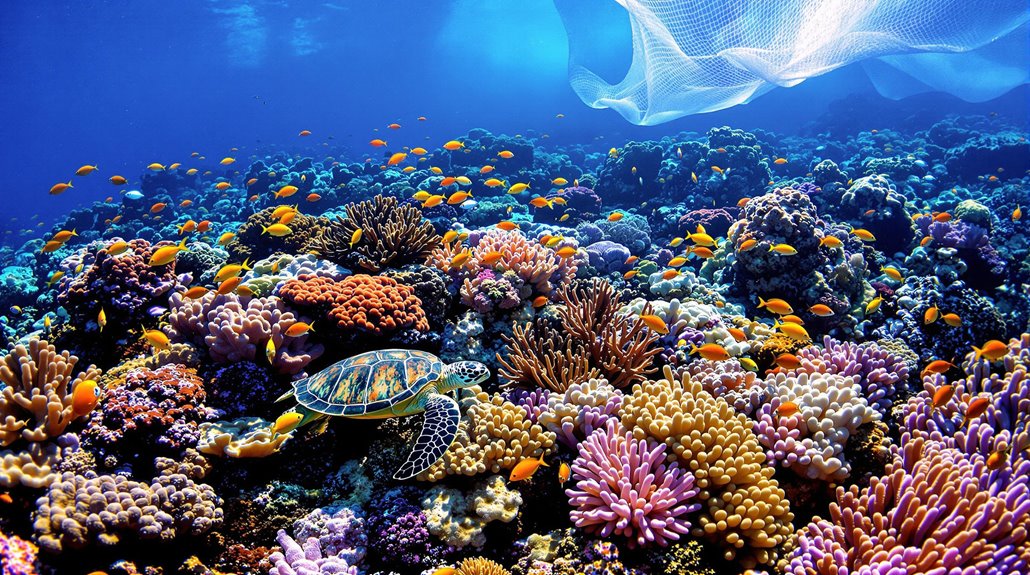Biodiversity is essential for stabilizing ecosystems, making them more resilient. When you have a variety of species, fundamental ecological roles are filled, ensuring that the ecosystem can thrive amidst changes. This variety helps with nutrient cycling and provides necessary services like pollination, critical for food production. Additionally, different species respond to disturbances at different times, preventing mass failures. As a result, higher biodiversity means ecosystems can absorb shocks and recover faster. Understanding these mechanisms shows why maintaining biodiversity is key to our planet's health. You'll want to explore more about how you can help support biodiversity for a better ecosystem.
Key Takeaways
- Biodiversity enhances ecosystem resilience by ensuring a variety of species fulfill essential ecological roles, promoting stability during environmental changes.
- Asynchronous species responses prevent simultaneous ecosystem crashes, allowing for recovery and continuity in ecosystem functions.
- Functional complementarity among species leads to quicker recovery from disturbances, maintaining overall ecosystem health.
- High species diversity reduces competition, fostering a stable environment and boosting productivity across ecosystems.
- Diverse interactions among species help prevent dominance by any one species, promoting balanced ecosystems that can better absorb shocks.
Importance of Biodiversity

Biodiversity isn't just a buzzword—it's fundamental for the health and stability of ecosystems. When you consider diverse ecosystems, you'll see they're more stable and resilient, especially during environmental changes.
A variety of species means that if one faces disease or disturbance, others can step in to perform essential ecological roles. This diversity also maintains nutrient cycling, ensuring critical nutrients are available for all life forms. Additionally, ecosystem stability is enhanced when a wide range of species is present, making the system more adaptable to changes.
Furthermore, biodiverse ecosystems provide significant pollination services necessary for plant reproduction and food production. With varied habitats supporting numerous species, biodiversity reduces extinction risks and keeps ecosystems balanced.
Biodiversity and Human Health

When ecosystems thrive, they directly contribute to human health and well-being. Clean air and water are indispensable, and diverse ecosystems guarantee we've access to both.
Biodiversity also plays an important role in food security, providing a variety of crops and livestock that enhance nutrition. Furthermore, many medicines come from the rich biological diversity found in nature, including those derived from natural compounds that offer health benefits. Additionally, the loss of biodiversity exacerbates issues like climate change, which can have detrimental effects on health.
By regulating climate and cycling nutrients, ecosystems maintain fertile soils that support healthy plant growth. Additionally, a diverse diet is fundamental for overall health, as different foods provide crucial micronutrients.
Maintaining biodiversity helps control disease-causing organisms, reducing the risk of infections. Ultimately, a rich tapestry of life enhances our physical and mental health, making biodiversity indispensable for a thriving society.
Mechanisms of Stability

Ecosystems thrive not just through biodiversity but also through various mechanisms that maintain their stability. One key mechanism is the asynchrony of species' responses to environmental changes. When some species respond quickly while others lag behind, it prevents synchronized crashes, ensuring ongoing ecosystem function. Additionally, differences in species' response speeds create functional complementarity—some species recover swiftly from disturbances, while others provide long-term stability. Reduced competition among species further enhances stability, allowing diverse interactions and higher productivity. High levels of species diversity contribute to these dynamics, promoting overall ecosystem health and resilience.
Together, these mechanisms foster resilience, enabling ecosystems to absorb shocks and adapt to changing conditions. By understanding these processes, you can appreciate the intricate balance that sustains our natural world.
Research Evidence

While many factors contribute to the stability of ecosystems, research consistently shows that higher species diversity plays an essential role.
When you increase species diversity, you enhance ecological roles, allowing multiple species to maintain balance. This diversity helps ecosystems withstand disruptions and absorb shocks, ensuring necessary services like climate regulation remain intact. Moreover, recent studies suggest that species diversity can significantly enhance ecosystem stability in the face of environmental changes.
Additionally, ecosystems with a variety of species foster more interactions, preventing any one species from dominating. Temporal and functional complementarity—where species respond differently to environmental changes—further stabilizes these systems.
Biodiversity Threats

Biodiversity faces significant threats that jeopardize the stability and resilience of ecosystems. Climate change shifts habitats, causing irreversible damage, like polar bears struggling for food as ice melts. Recent studies indicate that one million species are at risk of extinction in the coming decades, highlighting the urgency of the situation.
Pollution contaminates air, water, and soil, harming species and weakening ecosystems. You mightn't realize that over half of Earth's land has been altered, leading to habitat loss and increased extinction rates.
Overexploitation of species through overharvesting strains natural resources, pushing many species to the brink. Invasive species, introduced through global trade, outcompete natives, reducing biodiversity and causing economic damage.
As these threats escalate, you're witnessing a critical moment for our planet's health, making it essential to understand and address these challenges before it's too late.
Conservation Strategies

To guarantee the survival of our planet's diverse life forms, effective conservation strategies are essential.
Start by protecting and restoring habitats through national parks and wildlife sanctuaries, ensuring connectivity for species migration. Adopt sustainable resource management by promoting practices that minimize waste and prevent over-exploitation.
Incorporate ex-situ conservation, utilizing zoos and gene banks to safeguard endangered species while enabling research for future reintroduction. This approach is critical for addressing the increased vulnerability of ecosystems to disturbances.
Don't forget in-situ conservation, which preserves species within their natural habitats, allowing for evolutionary adaptation.
Finally, raise public awareness about the importance of biodiversity and enforce environmental laws to combat pollution.
Community Engagement

Effective conservation strategies must be complemented by strong community engagement. When you involve local communities, conservation efforts become culturally appropriate and gain essential support.
Local residents often hold extensive knowledge about their ecosystems, enhancing scientific understanding and project success. By including community members in decision-making, you guarantee that initiatives address their needs and foster a sense of ownership. This involvement not only motivates individuals to protect their environment but also leads to sustainable practices that endure over time. Building trust, providing education, and respecting cultural differences are key strategies for effective engagement. Community involvement often leads to long-term conservation practices that are crucial for ecosystem stability.
When communities take charge, projects can thrive, as seen in successes like the Amazon Basin and the Maya Biosphere Reserve, where local stewardship has greatly benefited biodiversity.
Frequently Asked Questions
What Are the Economic Benefits of Maintaining Biodiversity?
Maintaining biodiversity brings significant economic benefits for you and your business. It helps you avoid fines and legal issues, streamlining project approvals.
By understanding biodiversity impacts, you can mitigate supply chain disruptions and reduce compliance costs.
Additionally, showcasing your commitment to biodiversity enhances your brand reputation, attracting eco-conscious consumers. This not only fosters customer loyalty but can also lead to innovative product development and new market opportunities, ultimately boosting your bottom line.
How Does Biodiversity Affect Climate Resilience?
Biodiversity's like a superhero cape for our planet, giving it the strength to bounce back from climate challenges.
When you support diverse ecosystems, you're helping them regulate climate, manage water cycles, and prevent soil erosion.
These ecosystems act as natural shields against floods and droughts, making them more resilient to extreme weather.
Plus, they promote species adaptation, ensuring that nature's balance remains intact even in the face of change.
Can Urban Areas Support Biodiversity Effectively?
Yes, urban areas can effectively support biodiversity.
By creating green spaces, you provide habitats for various species, from birds to insects. Incorporating parks and gardens into your neighborhood helps connect wildlife corridors, allowing animals to thrive.
You can also advocate for sustainable urban planning that prioritizes nature-based solutions.
What Role Do Microorganisms Play in Ecosystem Stability?
"You can't see the forest for the trees," but in ecosystems, it's the microorganisms that often hold everything together.
These tiny organisms play crucial roles in nutrient cycling, soil health, and ecosystem services. They break down organic matter, fix nitrogen, and purify water, ensuring plants thrive.
When you maintain microbial diversity, you bolster ecosystem stability, making it resilient to disturbances.
How Does Education Influence Biodiversity Conservation Efforts?
Education influences biodiversity conservation efforts by increasing your awareness of ecosystems and the threats they face.
It helps you understand the importance of sustainable practices and species identification, fostering positive attitudes towards wildlife.
As you engage with conservation concepts, you develop critical thinking skills and the ability to evaluate environmental issues.
This knowledge encourages you to participate in community conservation initiatives, promoting long-term behavior changes that benefit biodiversity and ecosystem health.
Conclusion
In a world where nature's delicate balance hangs by a thread, embracing biodiversity isn't just an option—it's a necessity. By valuing the rich tapestry of life around us, we're not only safeguarding ecosystems but also securing our own health and future. Just as each thread in a fabric contributes to its strength, every species plays an essential role in resilience. So, let's come together to protect this incredible diversity; after all, our survival depends on it.









